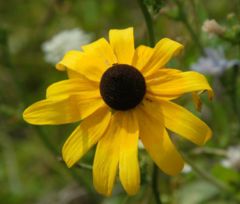Rudbeckia hirta
| subsp. var. | ||||||||||||||||||||||||||||||||||||||||||||||||||||||||
|---|---|---|---|---|---|---|---|---|---|---|---|---|---|---|---|---|---|---|---|---|---|---|---|---|---|---|---|---|---|---|---|---|---|---|---|---|---|---|---|---|---|---|---|---|---|---|---|---|---|---|---|---|---|---|---|---|

|
|
| ||||||||||||||||||||||||||||||||||||||||||||||||||||||
| ||||||||||||||||||||||||||||||||||||||||||||||||||||||||
| Standard Cyclopedia of Horticulture |
|---|
|
Rudbeckia hirta, Linn. Black-eyed Susan. Yellow daisy. Biennial or annual, 1-3 ft. high, simple or branched, hispid: lvs. 2-5 in. long: rays golden yellow, sometimes orange at base. Dry and open ground; common over wide range and often rather a troublesome weed. B.B. 3:416. Gn. 49:154.—R. conspicua, Hort., is probably only a garden form with long narrow orange-yellow ray-florets and a black disk. Var. vomerensis, Hort., differs from the type in having larger fl.-heads with broad ray-fls. which are light canary to golden yellow.
|
| Rudbeckia hirta {{{status}}} Fossil range: {{{fossil_range}}}
| ||||||||||||||||||||||||||||||||||||||||||||||||||||||||||||||||||
|---|---|---|---|---|---|---|---|---|---|---|---|---|---|---|---|---|---|---|---|---|---|---|---|---|---|---|---|---|---|---|---|---|---|---|---|---|---|---|---|---|---|---|---|---|---|---|---|---|---|---|---|---|---|---|---|---|---|---|---|---|---|---|---|---|---|---|
 Rudbeckia hirta flowerhead | ||||||||||||||||||||||||||||||||||||||||||||||||||||||||||||||||||
| Plant Info | ||||||||||||||||||||||||||||||||||||||||||||||||||||||||||||||||||
| ||||||||||||||||||||||||||||||||||||||||||||||||||||||||||||||||||
| Scientific classification | ||||||||||||||||||||||||||||||||||||||||||||||||||||||||||||||||||
| ||||||||||||||||||||||||||||||||||||||||||||||||||||||||||||||||||
| [[{{{diversity_link}}}|Diversity]] | ||||||||||||||||||||||||||||||||||||||||||||||||||||||||||||||||||
| {{{diversity}}} | ||||||||||||||||||||||||||||||||||||||||||||||||||||||||||||||||||
| Binomial name | ||||||||||||||||||||||||||||||||||||||||||||||||||||||||||||||||||
| Rudbeckia hirta L. | ||||||||||||||||||||||||||||||||||||||||||||||||||||||||||||||||||
| Trinomial name | ||||||||||||||||||||||||||||||||||||||||||||||||||||||||||||||||||
| {{{trinomial}}} | ||||||||||||||||||||||||||||||||||||||||||||||||||||||||||||||||||
| Type Species | ||||||||||||||||||||||||||||||||||||||||||||||||||||||||||||||||||
| {{{type_species}}} | ||||||||||||||||||||||||||||||||||||||||||||||||||||||||||||||||||
| {{{subdivision_ranks}}} | ||||||||||||||||||||||||||||||||||||||||||||||||||||||||||||||||||
| [[Image:{{{range_map}}}|{{{range_map_width}}}|]] | ||||||||||||||||||||||||||||||||||||||||||||||||||||||||||||||||||
| Synonyms | ||||||||||||||||||||||||||||||||||||||||||||||||||||||||||||||||||
| {{{synonyms}}} |
Rudbeckia hirta (Black-eyed Susan, Blackiehead, Brown Betty, Brown Daisy, Brown-eyed Susan, Gloriosa Daisy, Golden Jerusalem, Nigger Daisy, Poorland Daisy, Yellow Daisy, Yellow Ox-eye Daisy) is a flowering plant in the family Asteraceae. It is an upright annual (sometimes biennial or perennial) native to most of North America, and is one of a number of plants with the common name Black-eyed Susan that also has purple on the side.
The plant can reach a height of 1-2 m. It has alternate, mostly basal leaves 20-75 cm long, covered by coarse hair. It flowers from June to August, with inflorescences measuring 10-15 cm in diameter (up to 30 cm in some cultivars), with yellow ray florets circling a brown, domed center of disc florets.
There are four varieties:
- Rudbeckia hirta var. angustifolia. Southeastern United States (South Carolina to Texas).
- Rudbeckia hirta var. floridana. Florida, endemic.
- Rudbeckia hirta var. hirta. Northeastern United States (Maine to Alabama).
- Rudbeckia hirta var. pulcherrima. Widespread in most of North America (Newfoundland to British Columbia, south to Alabama and New Mexico; naturalized Washington to California).
Symbolism and uses
Black-eyed Susan was designated the state Floral Emblem of Maryland in 1918.
Numerous cultivars have been selected for garden planting; some popular ones include 'Double Gold', 'Indian Summer', and 'Marmalade'.
The roots of Rudbeckia hirta have been used in a warm infusion to wash on sores and snake bites, and to make medicinal drinks for treating colds and worms in children. Ooze from the roots had been used as drops for earaches.
-
Rudbeckia hirta 'Indian summer'
-
Rudbeckia hirta 'Indian summer'
-
Rudbeckia hirta in southern Maine.
References
- Germplasm Resources Information Network: Rudbeckia hirta
- USDA Plant Profile: Rudbeckia hirta
- Rudbeckia hirta Large format diagnostic photographs
- A Tale of Two Susans non-scholarly essay on the etymology and history



